|
 |
 Автор: Williams Автор: Williams
 Дата: 3 мая 2018 Дата: 3 мая 2018
 Просмотров: 1 708 Просмотров: 1 708 |
| |
C.W. Fetter, Thomas Boving, David Kreamer - Contaminant Hydrogeology Third Edition
Waveland Press, 2018
pdf, 663 pages, english
ISBN-13: 978-1478632795
ISBN-10: 1478632798

Tremendous progress has been made in the field of remediation technologies since the second edition of Contaminant Hydrogeology was published two decades ago, and its content is more important than ever. Recognizing the extensive advancement and research taking place around the world, the authors have embraced and worked from a larger global perspective. Boving and Kreamer incorporate environmental innovation in studying and treating groundwater/soil contamination and the transport of those contaminants while building on Fetter's original foundational work.
Thoroughly updated, expanded, and reorganized, the new edition presents a wealth of new material, including new discussions of emerging and potential contaminant sources and their characteristics like deep well injection, fracking fluids, and in situ leach mining. New sections cover BET and Polanyi adsorption potential theory, vapor transport theory, the introduction of the Capillary and Bond Numbers, the partitioning interwell tracer testing technique for investigating NAPL sites, aerial photographic interpretation, geophysics, immunological surveys, high resolution vertical sampling, flexible liner systems, groundwater tracers, and much more.
Contaminant Hydrogeology is intended as a textbook in upper level courses in mass transport and contaminant hydrogeology, and remains a valuable resource for professionals in both the public and private sectors. |
| |
 Читать статью дальше (комментариев - 16)
Читать статью дальше (комментариев - 16)
| |
|
 |
 Автор: Williams Автор: Williams
 Дата: 22 апреля 2018 Дата: 22 апреля 2018
 Просмотров: 1 644 Просмотров: 1 644 |
| |
Heat Exchanger Design Handbook, 1983
Hemisphere Publishing, 1983
pdf, 2305 pages, english
ISBN: 3-1841-9080-3
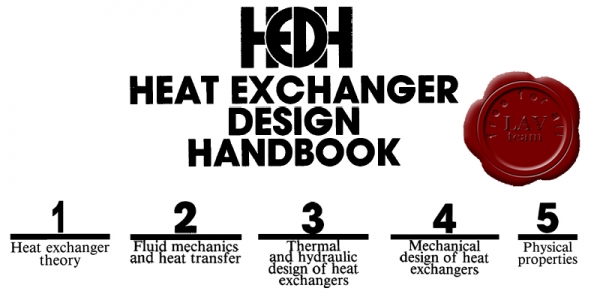
The Heat Exchanger Design Handbook (HEDH) had its origins in the 1970s when, under the chairmanship of Professor Ernst Schlilnder, a group of us began to discuss the possibility of a handbook dealing with all aspects of heat exchanger design and operation including the basic design methodology, the associated heat transfer and fluid flow technology and the physical data required for design. This led to the adoption of a structure consisting of 5 Parts as follows:
- Part 1: Heat exchanger theory and generic application technology
- Part 2: Fluid mechanics and heat transfer
- Part 3: Thermal and hydraulic design of heat exchangers
- Part 4: Mechanical design of heat exchangers
- Part 5: Physical properties
The first (loose-leaf) edition of HEDH was published in 1983 by Hemisphere Publishing Corporation and contained about 1500 pages of new material structured as indicated above; the reception from reviewers and users was very positive and this encouraged the publishers to publish a series of five Supplements of additional material for inclusion in the loose-leaf binders. This process added around 500 pages to the material. In order to achieve a more systematic updating, a quarterly update journal Heat Exchanger Design Update (HEDU) was started in 1983 which carried new material for HEDH. |
| |
 Читать статью дальше (комментариев - 12)
Читать статью дальше (комментариев - 12)
| |
|
 |
 Автор: Williams Автор: Williams
 Дата: 20 апреля 2018 Дата: 20 апреля 2018
 Просмотров: 1 174 Просмотров: 1 174 |
| |
VDI Heat Atlas, Second Edition
Springer, 2010
pdf, 1609 pages, english
ISBN: 978-3-540-77876-9
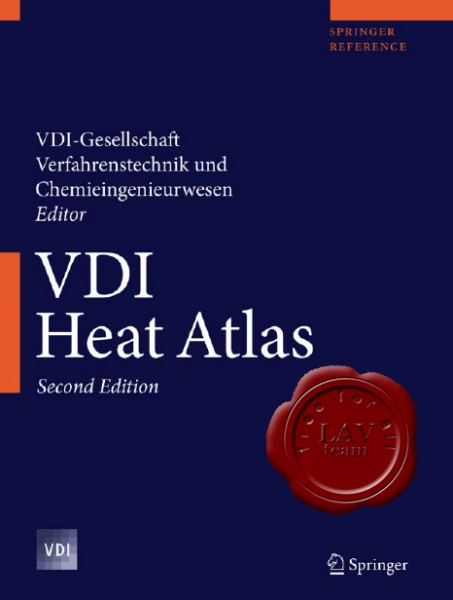
The VDI-Warmeatlas or VDI Heat Atlas has a long-lasting history and it can be considered as a standard book for heat exchanger and process engineering equipment design. It is not conceived as a textbook presenting an overall view of the theoretical or experimental findings in heat transfer sciences. The aim was and is to present and explain the state of the art of engineering methods to solve industrially relevant heat transfer problems for apparatus design and process modeling. The first German edition was published in 1963. The sixth German edition was translated into English to meet the demands of the more and more internationally acting industry. This first English edition was published in 1992. Since then, the German edition was regularly updated until the tenth edition published in 2006. In view of today’s globally acting industry, the editorial board felt the necessity to revise the English edition in order to account for the most recent state of our knowledge. Instead of only translating the latest German edition, we preferred restructuring it at the same time because this also enabled us to include new subjects and to update methods according to the recent state of the art. This new structure will also serve as a basis for the forthcoming German edition. On behalf of the editorial board, I express my sincere thanks to the authors of the various sections for their contributions and kind cooperation. The editorial work was coordinated and assisted by Mrs. Sigrid Cuneus from Springer-Verlag, Berlin. We are indebted to her for the efficient work and pleasant collaboration. We are also grateful to Mrs. Tina Shelton from the Reference and Database Publishing group, Springer Reference Editorial, India, who handled the editorial workflow. |
| |
 Читать статью дальше (комментариев - 6)
Читать статью дальше (комментариев - 6)
| |
|
 |
 Автор: Williams Автор: Williams
 Дата: 24 марта 2018 Дата: 24 марта 2018
 Просмотров: 1 257 Просмотров: 1 257 |
| |
Balgaisha Mukanova, Igor Modin - The Boundary Element Method in Geophysical Survey
Springer, 2018
pdf, 162 pages, english
ISBN: 978-3-319-72907-7
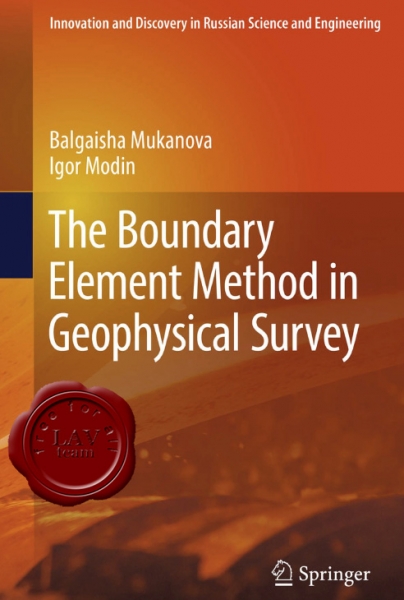
This volume is devoted to the application of the integral equations method (IEM) and boundary elements method (BEM) to problems involving the sounding of geological media using direct current (DC). Adaptive mesh generation algorithms and numerical methods for solving a system of integral equations are discussed. Integral equations for the media, which contains piecewise linear contact boundaries, immersed local inclusions, and subsurface relief, are derived and solved numerically. Describes in detail the application of the BEM and IEM to 2.5D direct problems using ERT for geological media with a complex structure and having a large number of internal contact boundaries. Provides algorithms of grid generation of the boundaries that are adapted to the geometry of the media, the surface relief and the measurements of electrode arrays. Discusses the application of the BEM to 3D sounding problems using the ERT method. Illustrates the applications of inversion programs to synthetic data generated using the BEM in comparison with the original model and discusses the quality of the associated interpretation. |
| |
 Читать статью дальше (комментариев - 9)
Читать статью дальше (комментариев - 9)
| |
|
 |
 Автор: Williams Автор: Williams
 Дата: 23 марта 2018 Дата: 23 марта 2018
 Просмотров: 2 525 Просмотров: 2 525 |
| |
Pinliang Dong, Qi Chen - LiDAR Remote Sensing and Applications
CRC, 2018
pdf, 221 pages, english
ISBN: 978-1-4822-4301-7
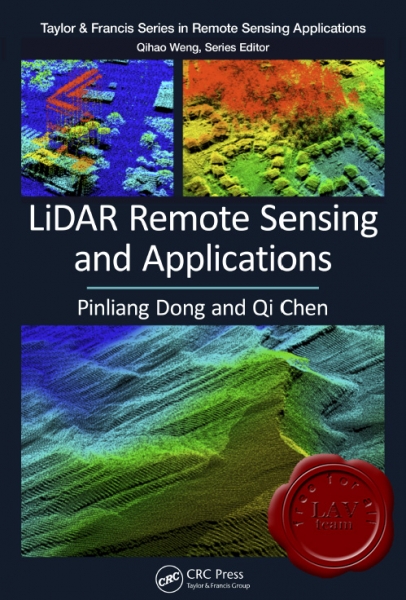
This is a unique book in that it smoothly combines LiDAR principles, data processing methods, applications, and hands-on practices, following an overview of remote sensing. An index map of LiDAR data and a list of abbreviations are also included to improve the readability of the book. For forest applications, readers can find examples such as creating leaf-on and leaf-off canopy height models in Susquehanna Shale Hills, PA; identifying disturbances from lightning and hurricane in mangrove forests in Florida; and estimating aboveground biomass in tropical forests in Ghana. For urban applications, readers can see examples such as road extraction, powerline corridor mapping, and population estimation in Denton, TX; parcel-based building change detection in Surrey, Canada; and road blockage detection in Port-au-Prince after the 2010 Haiti earthquake. For geoscience applications, readers can explore samples such as measuring dune migration rates in White Sands, NM; analysis of offset channels associated with the San Andreas Fault in California; and trend surface analysis and visualization of rock layers in Raplee Ridge, UT. Undergraduate and graduate students will find that the 11 step-by-step GIS projects with LiDAR data can really help them understand LiDAR data processing, analysis, and applications, while professionals and researchers will benefit from various topics on LiDAR remote sensing and applications, along with over 500 references in the book. |
| |
 Читать статью дальше (комментариев - 22)
Читать статью дальше (комментариев - 22)
| |
|
 |
 Автор: Williams Автор: Williams
 Дата: 18 марта 2018 Дата: 18 марта 2018
 Просмотров: 4 670 Просмотров: 4 670 |
| |
Jeanne Aarhus - Migrating from AutoCAD to MicroStation Intermediate

While MicroStation and AutoCAD share some similar elements, there are enough differences to make transitioning from one CAD application to the other somewhat challenging. If you're planning on making the switch from AutoCAD to MicroStation, this course can help by illustrating how to leverage your existing AutoCAD knowledge to get up to speed with MicroStation. Jeanne Aarhus builds on the concepts covered in Migrating from AutoCAD to MicroStation, and provides a comparison between corresponding intermediate features in MicroStation V8i-SS4 and AutoCAD 2018. Jeanne covers additional draw commands, shares techniques for working with text and dimensions, explains how to use measure commands, and more.
Topics include:
- Placing, points, curves, and line streams
- Editing text
- Working with dimensions
- Element attributes
- Changing the display and scales of various lifestyle types
- Working with groups
- Modifying and manipulating fences
- Using measure commands
- Working with cells
|
| |
 Читать статью дальше (комментариев - 14)
Читать статью дальше (комментариев - 14)
| |
|
 |
 Автор: Williams Автор: Williams
 Дата: 16 марта 2018 Дата: 16 марта 2018
 Просмотров: 5 234 Просмотров: 5 234 |
| |
Akbar R. Tamboli - Handbook of Structural Steel Connection Design and Details
McGraw-Hill Education, 2017
pdf, 652 pages, english
ISBN: ISBN-13: 978-1259585517
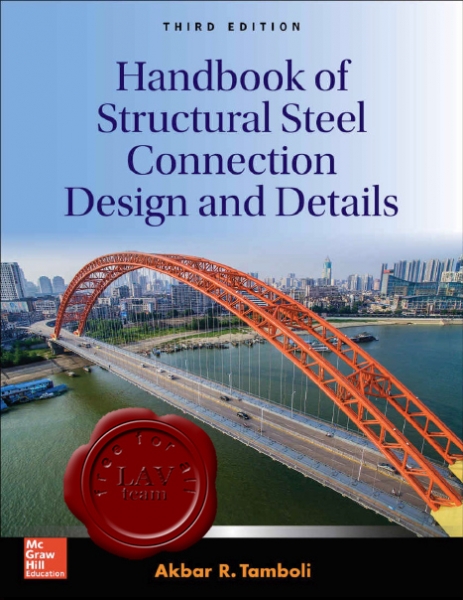
Fully updated with the latest AISC and ICC codes and specifications, Handbook of Structural Steel Connection Design and Details, Second Edition, is the most comprehensive resource on load and resistance factor design (LRFD) available. This authoritative volume surveys the leading methods for connecting structural steel components, covering state-of-the-art techniques and materials, and includes new information on welding and connections. Hundreds of detailed examples, photographs, and illustrations are found throughout this practical handbook.
Handbook of Structural Steel Connection Design and Details, Second Edition, covers:
- Fasteners and welds for structural connections.
- Connections for axial, moment, and shear forces.
- Welded joint design and production.
- Splices, columns, and truss chords.
- Partially restrained connections.
- Seismic design.
- Structural steel details.
- Connection design for special structures.
- Inspection and quality control.
- Steel deck connections.
- Connection to composite members.
|
| |
 Читать статью дальше (комментариев - 30)
Читать статью дальше (комментариев - 30)
| |
|
 |
 Автор: Williams Автор: Williams
 Дата: 12 марта 2018 Дата: 12 марта 2018
 Просмотров: 3 856 Просмотров: 3 856 |
| |
Paolo Rugarli - Steel Connection Analysis
Wiley-Blackwell, 2018
pdf, 537 pages, english
ISBN: 978-1-119-30346-6
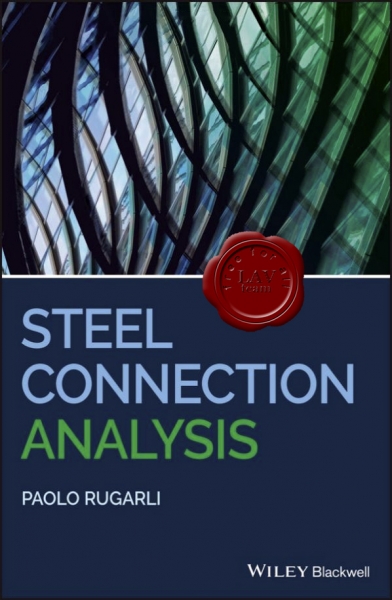
Steel connection analysis and checking is one of the most complex problems in structural engineering, and even though we use very powerful computing tools, it is still generally done using very simplistic approaches. Fromthe point of view of a typical structural engineer, the problem to solve is to design and check nodes, not single connections, i.e. a number of connections between a number of different members – maybe tens or even hundreds of load combinations, inclined member axes, and generic stress states. In a typical 3D structure there may be several tens of such nodes, or maybe even hundreds, which may be similar, or may be different from one another; identifying nodes that are equal is one of the problems that the designer has to face in order to reduce the number of different possible solutions, and in order to get a rational design. However, this problem of detecting equal nodes has not been sufficiently researched, and there are currently no tools that are able to properly solve this issue. If posed with the due generality, the problem of checking 3D nodes of real structures has not been solved by automatic computing tools. Also, because a general method of tackling all these problems is apparently still lacking, usually a few "cooking recipes” have been used to solve a limited number of typical, recurring (2D assimilated) nodes. Indeed, it often happens that true, real world nodes have to be analyzed by such recipes, despite the fact that the basic hypotheses needed to apply these recipes do not always hold true. This poses a serious problem because although these "cooking recipes” have been widely used, in the past few years they have been applied to 3D structures designed using computer tools, in the non-linear range, perhaps in seismic areas, and with the aim of reducing the weight of steel. The effects of such oversimplification have already been seen in many structures where steel connections have failed, especially in seismic areas (e.g. Booth 2014), but even in non-seismic areas (e.g. White et al. 2013, Bruneau et al. 2011). Generally speaking, it is well known that connections are one of the most likely points of weakness of steel structures, one of the most cumbersome to design – indeed one of the least designed – and one of the least software-covered in structural engineering. |
| |
 Читать статью дальше (комментариев - 22)
Читать статью дальше (комментариев - 22)
| |
|
 |
 Автор: Williams Автор: Williams
 Дата: 8 марта 2018 Дата: 8 марта 2018
 Просмотров: 1 609 Просмотров: 1 609 |
| |
Shenglai Yang - Fundamentals of Petrophysics Second Edition
Springer Geophysics, 2017
pdf, 509 pages, english
ISBN 978-3-662-55028-1

This book presents fundamental physical and physicochemical knowledge involved in oil and gas development engineering, such as physical and chemical phenomena, physical process. It is arranged to provide the knowledge of porous rock properties of reservoir rocks, and properties of fluids, i.e., gases, hydrocarbon liquids, and aqueous solutions, and the mechanism of multiphase fluid flow in porous media. The book also brings together the application of the above theories and knowledge. This textbook is written to serve the undergraduate teaching of the petroleum engineering major. It focuses on the introduction of basic conceptions, terms, definitions, and theories, placing more emphasis on the width of knowledge rather than the depth. What should be learned through the course includes the definitions of some essential physical parameters, the physical process, important physical phenomena, influencing factors, and engineering applications. In addition, the measuring methods and experimental procedures for the key parameters are also included. Through the study of this book, good foundation of knowledge frame for petroleum engineering should be established for students, which is benefit for both their further studying and their work in the future when they are engaged in job. |
| |
 Читать статью дальше (комментариев - 10)
Читать статью дальше (комментариев - 10)
| |
|
 |
| ПОИСК ПО САЙТУ |
 |
|
 |
| КАЛЕНДАРЬ | | |
 |
| « Октябрь 2025 » |
|---|
| Пн | Вт | Ср | Чт | Пт | Сб | Вс |
|---|
| | 1 | 2 | 3 | 4 | 5 | | 6 | 7 | 8 | 9 | 10 | 11 | 12 | | 13 | 14 | 15 | 16 | 17 | 18 | 19 | | 20 | 21 | 22 | 23 | 24 | 25 | 26 | | 27 | 28 | 29 | 30 | 31 | |
|
 | |
| |
|